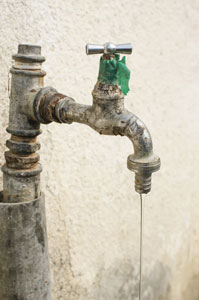
- The TRUTH About America's Water
- Water Pollutants that Cause Illness
- Are Minerals in Water Important for Health?
- Top 5 Drinking Water Contaminants
- Do I Need a Whole House Water Filter?
The Basic Type of Corrosion Explained
When water is acid, or even slightly alkaline, it has a tendency to be corrosive. No doubt, you have seen examples of how strong acids have rapidly dissolved metals. When water is low in pH, the same type of action occurs, although at a slower rate. Acid water may be traced to several different causes. For example, it may be acid due to the presence of certain dissolved gases, such as carbon dioxide, or hydrogen sulfide. The acidity may also be due to certain acid industrial wastes.

My waters frequently contain high concentrations of strong acids and are probably the most corrosive of all "natural" water supplies. In addition, they are frequently heavily charged with iron. These mine waters can, however, be satisfactorily treated, providing their sulfate content is not too great. When acid water attacks the walls of a metal container, the entire metal surface usually corrodes rather evenly. An exception occurs where water flows in a steady, consistent pattern through a container. When this happens, the water is likely to eat deep grooves in the metal.
Curiously, byproducts of corrosion frequently act to protect metals from further attack. One common byproduct is hydrogen gas. If the water is quiescent, the hydrogen gas acts as a protective film to prevent further corrosion. Another byproduct is zinc carbonate. This is found when galvanized pipe corrodes. Other byproducts vary depending on the type of metal. In many cases, they tend to act as a protective film. If these byproducts are swept away by the flow of the water, there is nothing to protect against the damaging effects of continuing corrosion.
The electrical conductivity of a water supply also affects its corrosive action. It is well known that an electrical current can be produced by immersing plates of dissimilar metals in a solution that conducts electricity. Under such conditions, a definite and measurable amount of electricity will flow through a connection between the plates. This connection may be an external wire, or it may be direct contact between the metal plates.
For example, if plates of zinc and copper are placed in a solution that conducts electricity, and a wire connected between the plates, the following occurs:
- The zinc will pass into a solution as zinc ions.
- A flow of current will run through the connecting wire.
A similar situation may occur in a household plumbing system. It sometimes happens that zinc galvanized pipe comes in contact with copper or brass (a copper alloy). Under these circumstances, that second condition direct contact between the metal plate exists. As the water is an electrolytic solution (that is, capable of carrying an electric current), the zinc in the galvanized pipe will pass into the solution as zinc ions. The speed of this reaction increases with the conductivity of the water. Over a period of time, this loss of zinc ions can be detected in the deterioration of the pipe.
We can say then: When dissimilar metals are in contact in a solution that can carry an electric current, two actions occur:
- An electric current flows between the two metals.
- One of the metals gradually dissolves.

